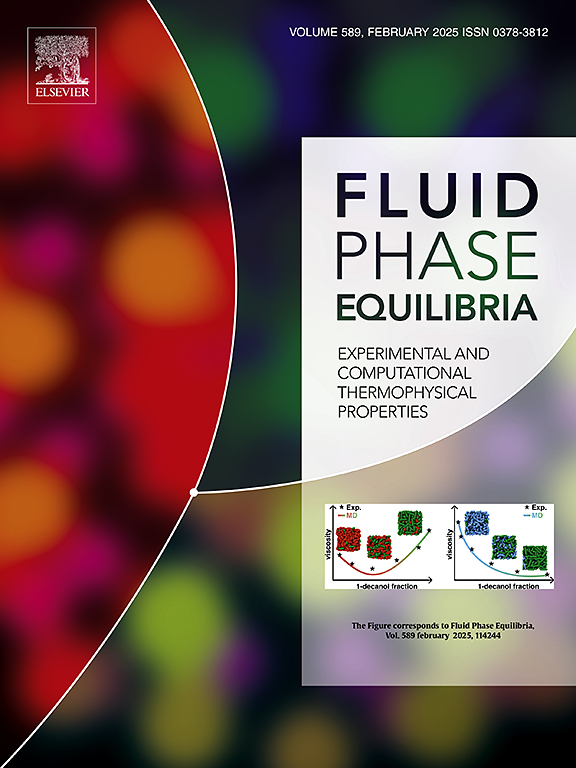Bubble point pressures for dimethyl ether – methanol, dimethyl ether – 2-methoxyethanol and dimethyl ether - 2-ethoxyethanol at (293.15–313.15) K, and their predictions considering pair interactions for three functional groups, -CH2OCH2-, -CH2OH and -CH2CH2CH2-
IF 2.7
3区 工程技术
Q3 CHEMISTRY, PHYSICAL
引用次数: 0
Abstract
2-Alkoxyethanols enhance the miscibility for aqueous solvents with a propellant, dimethyl ether, in spray cans. Therefore, the bubble point pressures (BPs) were measured for dimethyl ether – methanol, dimethyl ether - 2-methoxyethanol and dimethyl ether – 2-ethoxyethanol by using static apparatuses at (293.15–313.15) K. The experimental BPs were compared with the previous data of dimethyl ether – 2-butoxyethanol. The BPs were larger than those of ideal solution. The order was dimethyl ether – methanol > dimethyl ether - 2-methoxyethanol > dimethyl ether – 2-ethoxyethanol > dimethyl ether – 2-butoxyethanol. Analytical solution of groups (ASOG) model was modified for the predictions. The original model provides the activity coefficients by combining Flory-Huggins and Wilson equations, and the parameters have been determined for 43 functional groups. Only three groups, -CH2OCH2-, -CH2OH and -CH2CH2CH2-, were newly considered in this study. Then, 2-ethoxyethanol was assumed to be composed of -CH2OCH2-, -CH2OH and one-third of -CH2CH2CH2-. The group pair interaction parameters, for (-CH2CH2CH2- and -CH2OCH2-) and (-CH2CH2CH2- and -CH2OH), were determined from the literature data of vapor-liquid equilibria for propane - dimethyl ether and propane - methanol. Two different methods were employed to determine the parameters for (-CH2CH2CH2- and -CH2OH). One was from the BPs of dimethyl ether – methanol. The other was from those of dimethyl ether - 2-methoxyethanol. The better reproducibilities were obtained by the latter method. The average values of relative deviation for BP were 4.14, 3.62 and 4.37 % for dimethyl ether - 2-methoxyethanol, dimethyl ether - 2-ethoxyethanol and dimethyl ether - 2-butoxyethanol, respectively.

二甲醚-甲醇、二甲醚- 2-甲氧基乙醇和二甲醚- 2-乙氧基乙醇在(293.15-313.15)K下的泡点压力,以及考虑- ch2och2 -、- ch2oh和- ch2ch2ch2 -三个官能团对相互作用的预测
在喷雾罐中,2-烷氧乙醇增强了水溶液与推进剂二甲醚的混溶性。因此,在(293.15 ~ 313.15)k的温度下,用静态仪器测量了二甲醚-甲醇、二甲醚- 2-甲氧基乙醇和二甲醚- 2-乙氧基乙醇的泡点压力(bp),并将实验bp与二甲醚- 2-丁氧基乙醇的实验数据进行了比较。bp值大于理想溶液。顺序为:二甲醚-甲醇;二甲醚- 2-甲氧基乙醇;二甲醚- 2-乙氧基乙醇;二甲醚- 2-丁氧基乙醇。对分组解析解(ASOG)模型进行了修正。原始模型结合Flory-Huggins和Wilson方程给出活度系数,并确定了43个官能团的参数。本研究只考虑了- ch2och2 -、- ch2oh和- ch2ch2ch2 -三个基团。然后,假设2-乙氧基乙醇由- ch2och2 -、- ch2oh和三分之一的- ch2ch2ch2 -组成。根据丙烷-二甲醚和丙烷-甲醇汽液平衡的文献数据,确定了(- ch2ch2ch2 -和- ch2och2 -)和(- ch2ch2ch2 -和- ch2oh)的基团对相互作用参数。采用两种不同的方法测定(- ch2ch2ch2 -和- ch2oh)的参数。一个是二甲醚-甲醇的bp。另一种是二甲醚- 2-甲氧基乙醇。后一种方法的重现性较好。二甲醚- 2-甲氧基乙醇、二甲醚- 2-乙氧基乙醇和二甲醚- 2-丁氧基乙醇对BP的平均相对偏差分别为4.14%、3.62%和4.37%。
本文章由计算机程序翻译,如有差异,请以英文原文为准。
求助全文
约1分钟内获得全文
求助全文
来源期刊

Fluid Phase Equilibria
工程技术-工程:化工
CiteScore
5.30
自引率
15.40%
发文量
223
审稿时长
53 days
期刊介绍:
Fluid Phase Equilibria publishes high-quality papers dealing with experimental, theoretical, and applied research related to equilibrium and transport properties of fluids, solids, and interfaces. Subjects of interest include physical/phase and chemical equilibria; equilibrium and nonequilibrium thermophysical properties; fundamental thermodynamic relations; and stability. The systems central to the journal include pure substances and mixtures of organic and inorganic materials, including polymers, biochemicals, and surfactants with sufficient characterization of composition and purity for the results to be reproduced. Alloys are of interest only when thermodynamic studies are included, purely material studies will not be considered. In all cases, authors are expected to provide physical or chemical interpretations of the results.
Experimental research can include measurements under all conditions of temperature, pressure, and composition, including critical and supercritical. Measurements are to be associated with systems and conditions of fundamental or applied interest, and may not be only a collection of routine data, such as physical property or solubility measurements at limited pressures and temperatures close to ambient, or surfactant studies focussed strictly on micellisation or micelle structure. Papers reporting common data must be accompanied by new physical insights and/or contemporary or new theory or techniques.
 求助内容:
求助内容: 应助结果提醒方式:
应助结果提醒方式:


